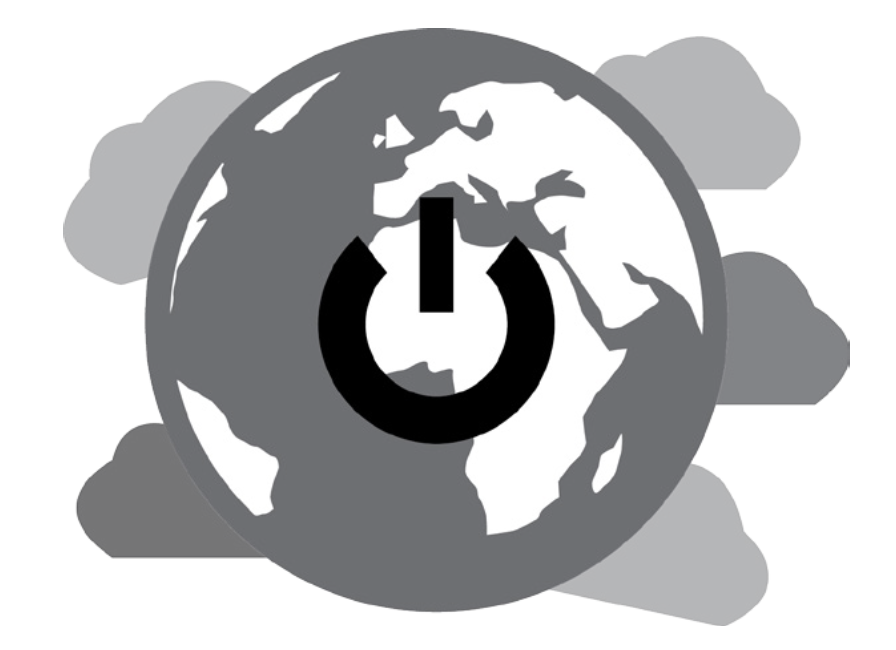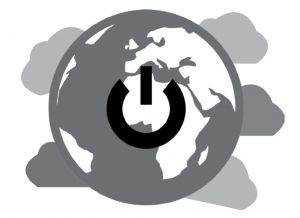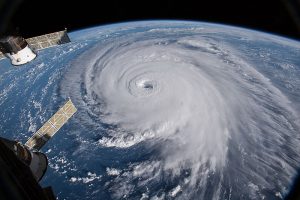Global Reset: Hurricane intensity worsens with changes in global climate
October 22, 2018
After Hurricane Michael and Hurricane Florence damaged the east coast of the United States, thousands of people continue to recover from the destruction.
According to the United States Census Bureau, the hurricane affected Maryland, North Carolina, South Carolina, Virginia, Florida, Georgia, and the District of Columbia, potentially impacting (directly or indirectly) almost 85 million people.
To understand why this hurricane was so devastating, let’s go back to how they form: Hurricanes start off with warm water in the tropics. Winds blow dust from the Sahara desert into the eastern Atlantic Ocean, triggering a condensation of the humidity in the air, which begins the storm.
The condensing water creates heat, warming the ocean underneath, which causes even more evaporation and condensation, thus creating an endless cycle that inflates the storm. Such hurricanes only stop when they encounter cold water or land (which cut off its supply of warm water).
However, when they move inland, they cause damage in three significant ways:
“One is [that] the storm literally pushes the ocean higher ahead of it, [in] what’s called storm surge,” biology teacher Mike Pistacchi said. “As the storm moves onto land, that creates the equivalent of massively high tide, [which] causes a lot of coastal damage.”
Second, the high wind speeds of the hurricane demolish buildings and cars.
“The third one is, once all that water dumps onto the land,it all has to make its way back to the sea, which creates all kinds of flooding,” Pistacchi said. “So low lying coastal communities like North Carolina are very, very vulnerable to… this deluge of water coming back down to the ocean.”
Furthermore, according to data from the National Oceanic and Atmospheric Administration (NOAA) website, tropical storms are beginning to slow down and remain in place for longer. Storms may be compounded by the impact of increased population as well.
“As more and more people move to the coast, that could cause a real negative impact in the future,” said Dan Gregoria, a senior forecaster at the National Weather Service in San Diego.“You can’t stop a hurricane, [so] I would say the most important thing is for people moving [to the coast] to be informed.”
Global warming may lead to an increase in intensity of tropical storms and hurricanes, but itis not the sole factor governing the formation of these storms.
“Global warming–that’s a complicated question. Warmer water produces bigger hurricanes… and global warming will drive up ocean temperatures.There’s no doubt about that correlation,” Pistacchi said. “That being said, whether or not we’ll get more storms depends on global climate patterns, which are also being altered by climate change. Right now, if anyone says ‘this storm was because of global warming’ it’s probably an oversimplified view of it. But the general picture is definitely on track with bigger storms.”
Though the connection between climate change and hurricanes has not yet been fully explored, the correlation is clear.
“All of the climate models have predicted if not more frequent hurricanes, hurricanes of greater magnitude. So greater magnitude is obviously going to do more damage than a more mild hurricane and so that definitely seems to be playing out,”upper school biology teacher Kate Schafer said. “Scientists have already developed the tools to calculate how much greater magnitude a hurricane is because of the already-felt effects of climate change.”


















![“[Building nerf blasters] became this outlet of creativity for me that hasn't been matched by anything else. The process [of] making a build complete to your desire is such a painstakingly difficult process, but I've had to learn from [the skills needed from] soldering to proper painting. There's so many different options for everything, if you think about it, it exists. The best part is [that] if it doesn't exist, you can build it yourself," Ishaan Parate said.](https://harkeraquila.com/wp-content/uploads/2022/08/DSC_8149-900x604.jpg)




![“When I came into high school, I was ready to be a follower. But DECA was a game changer for me. It helped me overcome my fear of public speaking, and it's played such a major role in who I've become today. To be able to successfully lead a chapter of 150 students, an officer team and be one of the upperclassmen I once really admired is something I'm [really] proud of,” Anvitha Tummala ('21) said.](https://harkeraquila.com/wp-content/uploads/2021/07/Screen-Shot-2021-07-25-at-9.50.05-AM-900x594.png)







![“I think getting up in the morning and having a sense of purpose [is exciting]. I think without a certain amount of drive, life is kind of obsolete and mundane, and I think having that every single day is what makes each day unique and kind of makes life exciting,” Neymika Jain (12) said.](https://harkeraquila.com/wp-content/uploads/2017/06/Screen-Shot-2017-06-03-at-4.54.16-PM.png)








![“My slogan is ‘slow feet, don’t eat, and I’m hungry.’ You need to run fast to get where you are–you aren't going to get those championships if you aren't fast,” Angel Cervantes (12) said. “I want to do well in school on my tests and in track and win championships for my team. I live by that, [and] I can do that anywhere: in the classroom or on the field.”](https://harkeraquila.com/wp-content/uploads/2018/06/DSC5146-900x601.jpg)
![“[Volleyball has] taught me how to fall correctly, and another thing it taught is that you don’t have to be the best at something to be good at it. If you just hit the ball in a smart way, then it still scores points and you’re good at it. You could be a background player and still make a much bigger impact on the team than you would think,” Anya Gert (’20) said.](https://harkeraquila.com/wp-content/uploads/2020/06/AnnaGert_JinTuan_HoHPhotoEdited-600x900.jpeg)

![“I'm not nearly there yet, but [my confidence has] definitely been getting better since I was pretty shy and timid coming into Harker my freshman year. I know that there's a lot of people that are really confident in what they do, and I really admire them. Everyone's so driven and that has really pushed me to kind of try to find my own place in high school and be more confident,” Alyssa Huang (’20) said.](https://harkeraquila.com/wp-content/uploads/2020/06/AlyssaHuang_EmilyChen_HoHPhoto-900x749.jpeg)















